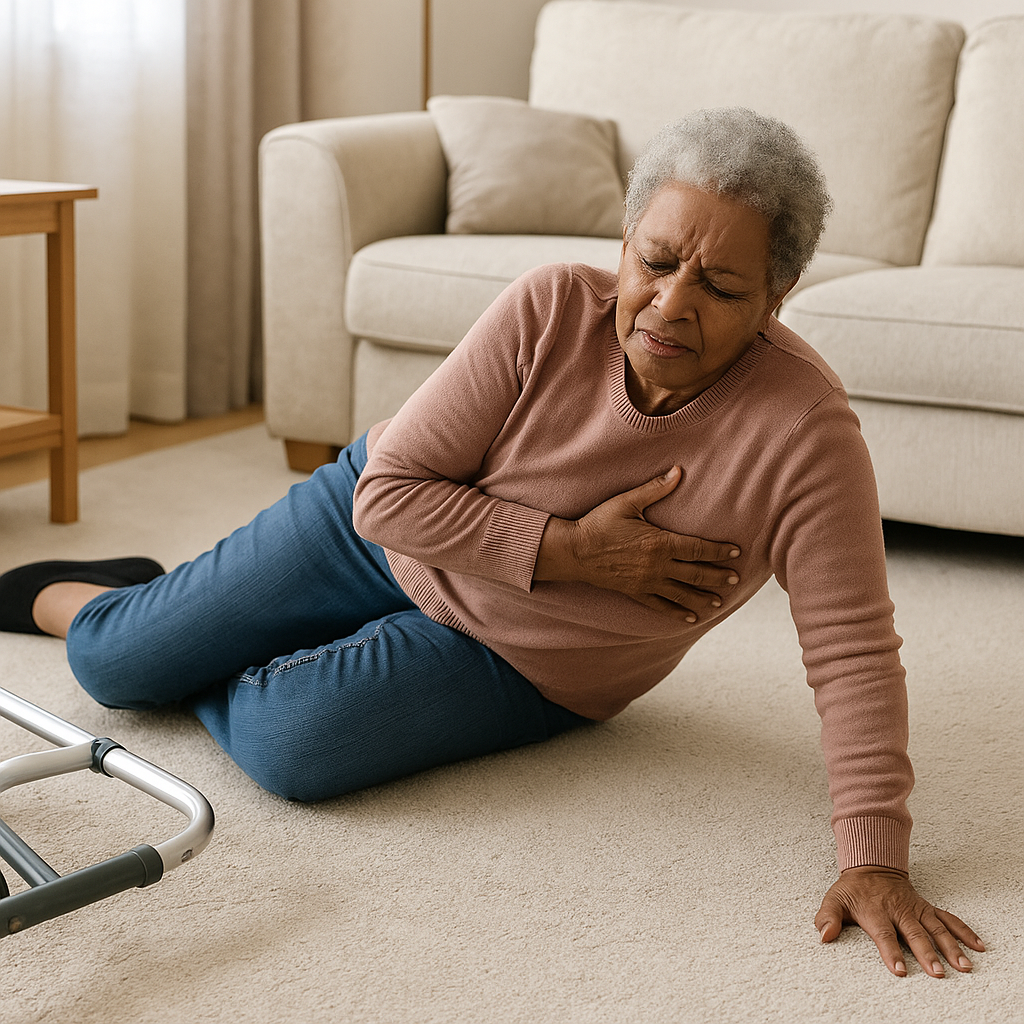A Gentle Guide for Seniors and Caregivers
Falls happen — even to the most careful people. What matters most isn’t that you fell, but how you recover afterward.
The moments, days, and weeks following a fall can feel confusing or even frightening. But with the right steps — physical, emotional, and environmental — you can rebuild both strength and confidence safely.
💬 Falling isn’t failure — it’s feedback that your body and surroundings need a little more care.
What to Do Immediately After a Fall
The first few minutes after a fall are critical. Stay calm and don’t rush to get up.
Take a moment to breathe, check for pain, and move only if you feel stable.
Step-by-Step Response
- Stay still and assess: Are you in pain? Can you move your arms and legs without sharp discomfort?
- Call for help: Use your phone, smartwatch, or alert button if one is nearby.
- Roll onto your side: If unhurt, slowly roll to your side to reduce pressure on your joints.
- Use furniture for support: Push up from a sturdy surface like a chair or couch — never pull yourself up.
- Rest before moving on: Sit for several minutes and make sure you’re not dizzy before standing fully.
If you hit your head, lost consciousness, or feel pain in your hips, knees, or back, call your doctor or 911. Some injuries aren’t obvious right away.
Regaining Confidence After a Fall
Falls often leave behind more than bruises — they can create fear and hesitation, which increase the risk of falling again.
You might start moving slower, avoiding certain activities, or withdrawing socially. This fear loop can weaken your body and confidence.
Gentle Ways to Rebuild Trust in Your Body
- Start small: Try simple movements like standing from a chair or walking a few steps with support.
- Use affirmations: Remind yourself — “I’m being careful, not fearful.”
- Talk openly: Share your experience with family or a physical therapist. Emotional healing is as important as physical recovery.
- Celebrate small wins: Each pain-free movement is progress worth acknowledging.
🌷 Confidence doesn’t return all at once — it grows, step by step.
Physical Recovery: Rebuilding Strength and Balance
Once your doctor clears you, gentle activity becomes your best medicine.
Movement keeps circulation strong, improves joint flexibility, and helps your brain relearn balance control.
Simple At-Home Recovery Exercises
- Seated Leg Lifts: Strengthens thighs and improves circulation.
- Ankle Circles: Keeps flexibility in your lower joints.
- Standing Heel Raises: Boosts ankle and calf stability.
- Wall Push-Ups: Builds upper-body strength safely.
- Balance Practice: Stand near a counter and shift weight from one foot to the other.
If you feel unsure, ask for a home visit from a physical therapist — they can tailor a plan to your comfort level.
Check for Underlying Causes
If a fall happened unexpectedly, it’s worth asking why. Sometimes it’s not just a slip — it could be related to vision changes, low blood pressure, or medication side effects.
Ask your doctor for a full review that includes:
- Vision and hearing screening.
- Blood pressure and hydration check.
- Medication review for dizziness or fatigue.
- Gait and balance assessment by a physical therapist.
Catching these causes early prevents future falls — and brings peace of mind.
Caring for the Emotional Side
For many older adults, the hardest part of a fall is emotional. You might feel embarrassed, worried about your independence, or anxious about another incident.
Healing Your Mind as You Heal Your Body
- Talk it out: Speak with a family member, counselor, or caregiver about how you feel.
- Join a balance class: Moving with others reduces fear and rebuilds trust in your ability.
- Stay connected: Loneliness increases fall risk — even light social activity supports recovery.
- Set gentle goals: Focus on recovery, not perfection.
💛 Recovery is about restoring self-belief — not just mobility.
Home Adjustments After a Fall
Every fall is a clue about what needs attention.
Walk through your home with fresh eyes:
- Remove throw rugs or replace them with non-slip mats.
- Add grab bars near beds, showers, and toilets.
- Improve lighting in hallways and stairs.
- Keep pathways wide and clutter-free.
- Reorganize shelves so daily items are easy to reach.
Consider adding motion lights or smart alerts if you live alone.
When to Ask for Professional Help
It’s always better to ask early than wait.
You should contact your doctor or a specialist if you:
- Experience dizziness, blurred vision, or sudden weakness.
- Have fallen more than once in six months.
- Feel anxious about walking even short distances.
- Need guidance choosing the right assistive device.
A fall doesn’t mean you’ve lost independence — it means your care plan needs adjustment.
The Road Back to Independence
Recovering after a fall takes patience and self-kindness. With consistent effort, most people regain full strength, confidence, and freedom.
The goal isn’t perfection — it’s preparedness.
Every small change — one exercise, one conversation, one safety upgrade — helps protect your future mobility.
🕊️ The best recovery isn’t just physical — it’s emotional resilience built through care and courage.
Recommended Reading
- Preventing Falls & Injuries: Everyday habits that reduce your risk.
- Physical Therapy for Strength and Balance: Expert guidance for safer movement.
- Smart Mobility Technology: Modern tools that support independence and safety.
💬 Frequently Asked Questions
1. What’s the first thing a senior should do after a fall?
Stay calm and assess for pain or injury before moving. If there’s any doubt, call for help or use your alert device. Avoid rushing to stand — moving too quickly can worsen hidden injuries.
2. How long does recovery take after a fall?
Recovery depends on your overall health and the severity of the fall. Minor bruises may heal within days, while regaining full strength and confidence can take several weeks of gentle movement and therapy.
3. Should you see a doctor even if you feel fine after a fall?
Yes. Many injuries, such as internal bruising or small fractures, may not be immediately painful. A quick check-up ensures there are no hidden issues that could cause problems later.
4. What helps rebuild confidence after a fall?
Gradual exercise, home safety updates, and support from loved ones or therapists help restore trust in your body. Each small success — standing, walking, or climbing stairs — reinforces confidence.
5. How can caregivers support someone recovering from a fall?
Caregivers can assist with gentle exercises, home safety checks, and medication reminders. Emotional reassurance is equally important — encouragement helps seniors rebuild confidence without fear.
6. Can technology help during recovery?
Yes. Smartwatches with fall detection, motion-sensor lights, and voice-activated assistants make recovery safer and easier. These tools offer independence while providing peace of mind for families.

